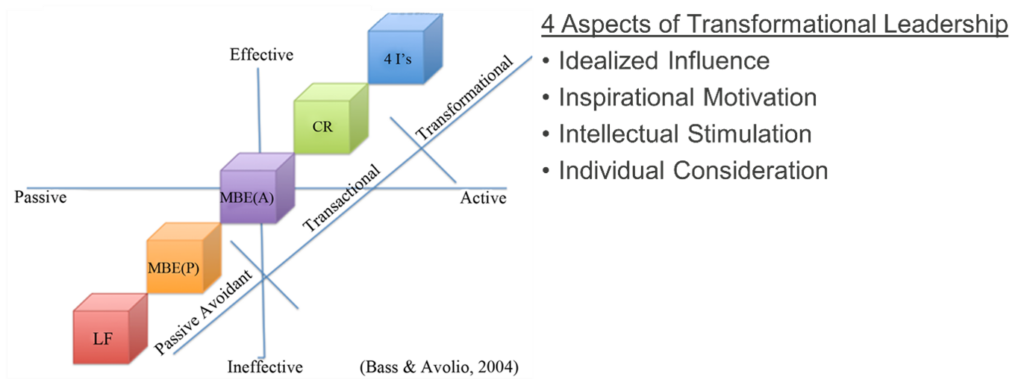A dated leadership theory is the Full Range Leadership Model.
This theory suggests that leaders generally have a leadership style when it comes to how they operate as a leader, which likely maps somewhere along this continuum from ineffective to effective and passive to active:

Here are some basic definitions of each style:
- Transformational leadership – Higher-ordered leadership that focuses on motivating and inspiring followers via idealized influence, inspirational motivation, intellectual stimulation, and individual consideration.
- Contingent Rewards (CR) – A transactional approach to leadership that focuses on ensuring teams and employees are effective at hitting targeted objectives.
- Management By Exception-Active (MBE(A)) – A transactional approach to leadership that focuses on ensuring fires and issues do not pop up.
- Management By Exception-Passive (MBE(P)) – A passive avoidant approach to leadership that focuses on putting out fires when they occur. Generally, such leaders wait around for something to go wrong before asserting their presence.
- Laissez-Faire Leadership (LF) – A hands-off approach to leadership. There is a general absence of action and presence.
While I am not a huge fan of this theory (perhaps largely because of how dated it is), I cannot ignore the fact that I can rather clearly place almost all of the leaders that I have worked with into one of these five boxes.
In fact, I am working with an executive team right now where the CEO, on his best days day, operates in MBE(A). While he sees himself as doing a good job, he cannot see that his lack of assertiveness is crippling his organization.
Considering this Theory Through the Lens of Vertical Development
Understanding the Full Range Leadership Model and the umbrella of vertical development, a light bulb has gone off for me. Let me explain…
Knowing that 92% of leaders operate at the CR level and below, and working a lot with such leaders, I have continually asked myself, why aren’t leaders more active and effective (or what I am going to simply call “assertive”)?
And, the same answer keeps manifesting itself. The answer, at a foundational level, is fear.
A primary reason why leaders aren’t more assertive is that they are fearful of assertiveness.
I have observed the following:
- A VP who is reluctant to inspire his team through purpose because he doesn’t think he’ll be in his position for much longer, and doesn’t want to “mess stuff up for the next leader.”
- A COO who is primarily focused on hitting short term objectives as opposed to leading through purpose because she is afraid that if she takes her eyes and emphasis off of results, they won’t “hit their metrics,” which would reflect poorly on her and her potential with the company.
- A small business owner who is organized, but largely uninspiring because he doesn’t think highly of himself and that he can be inspiring to others.
- A CEO who is good, but would not rank highly on idealized influence, inspirational motivation, intellectual stimulation, and individual consideration, largely because he is afraid to step out of his comfort zone (I am not sure he fully recognizes this).
How does this pertain to vertical development?
Vertical development is all about helping leaders heal themselves so that they can rise above their fears and insecurities and operate at the highest level.
Getting leaders to go from whatever level they are currently at to a higher, more elevated level will not occur by simply helping them develop greater knowledge and skills (i.e., horizontal development). They need to deepen their self-awareness, awaken to their self-protective fears and mindsets, and develop more value creating mindsets and strategies.
Knowing this, What are You Going to Do?
Do you have leaders that are operating at less-than-ideal levels? Do you need help elevating your leaders?
If the answer to either of these questions is “yes,” let’s connect.











2 Responses
The article raises a crucial point about leadership styles and their effectiveness, yet I agree that traditional leadership models can be overly limiting. Leadership, by nature, involves dealing with complex human behaviors that rarely fit neatly into predefined categories or ‘boxes’. This complexity suggests that achieving real emotional and cognitive growth often transcends what can be taught through standard leadership training alone.
To truly evolve leadership consciousness, a dual approach involving both coaching and therapy can be invaluable. A coach can play a pivotal role in uncovering the underlying fears that hold leaders back, guiding them towards greater self-awareness and the discovery of more empowering mindsets. However, therapists are crucial in providing the deeper psychological tools needed to face these fears head-on, facilitating a kind of introspection that might be beyond the reach of coaching alone.
This intentional and mindful work, when combined, can catalyze a profound transformation in leadership consciousness. It moves beyond merely adapting leadership styles to transforming the leader’s entire approach to their role and responsibilities. By addressing both the behavioral/cognitive aspects with coaching and the deeper emotional underpinnings with therapy, leaders can unlock a more assertive and effective style that is genuinely reflective of their capabilities and aspirations.
Well said, Ardi!